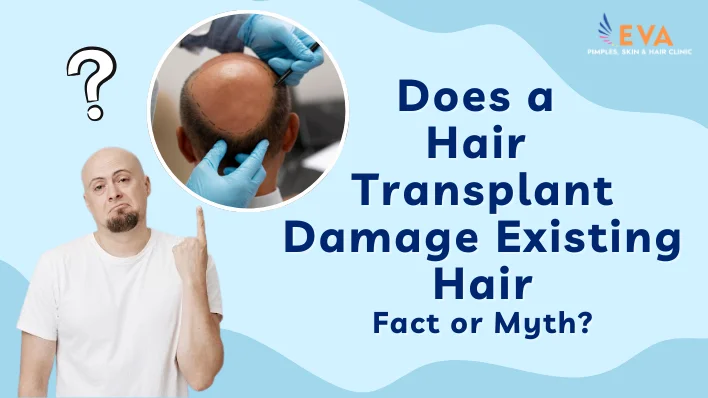Does a Hair Transplant Damage Existing Hair – Fact or Myth?
Home | Blogs | Does a Hair Transplant Damage Existing Hair – Fact or Myth?


Are you thinking of a hair transplant but wondering if it will damage your existing hair? Well, then you aren’t alone. As a hair clinic in Pune, we receive many people who have their perceptions about hair transplants. This is one of them. But does a hair transplant damage your natural hair or is it a myth? Let’s explore the truth!
Key Topics Discussed in This Article
Hair Transplant May Damage Existing Hair- Truth or Myth?
Let’s answer the question right away without keeping you waiting any longer. A hair transplant doesn’t damage your existing hair. Thus, it is a misconception people usually live with. They hear it somewhere and consider it true. But as hair transplant experts, we deem hair damage after a hair transplant a myth! A hair transplant affects your hair for sure. However, it does so only to a small percentage of your hair at the transplant site. And that too temporarily.
What Happens to Your Existing Hair After a Hair Transplant?
As we stated earlier, a hair transplant doesn’t damage your hair. However, it affects the transplanted region. So, after a hair transplant, the existing hair in the recipient area may shrink. It may reduce in size and temporarily shed around the transplanted region.
What Damages the Hair Follicles?
A hair transplant doesn’t damage hair. However, what if it damages the hair follicles? Well, that’s a possibility! But fret not. It doesn’t happen for nothing. A few circumstances may cause it. Some of them include the following.
An Inexperienced Surgeon
An inexperienced surgeon performing the transplant independently may end up ruining the outcome! Now, what do we mean by that? You won’t see any hair growth at the transplant site. Instead, you may suffer from hair thinning, lifelong scarring, and hair fall. Thus, it goes without saying that you need an expert and experienced surgeon to perform the process to deliver the desired results. Accordingly, examine the surgeon’s expertise and track record. Besides, hair transplants involve a sizable investment. So, ensure you make an informed choice.
Medication Reactions
Everybody is unique and responds distinctly to every treatment and medication. Some people undergo unprecedented hair loss after the procedure. If you do so, consult your surgeon before the problem intensifies. Your surgeon will diagnose the problem and determine if the uncontrollable hair loss is your body’s response to the medications you’ve been consuming.
Injury to the New Transplanted Hair Follicles
Aftercare is as crucial as the transplant procedure. You may end up injuring your implanted grafts if your surgeon doesn’t provide the right aftercare or if you fail to adhere to their instructions. An injury to the newly transplanted hair follicles can increase the risk of complications and hinder proper hair regrowth.
Understanding Hair Transplant Treatment Better
FUE Hair Transplant Procedure
During the process, surgeons extract the intact hair follicles from the donor site and transplant them into the affected regions. The procedure temporarily affects only a tiny portion of the existing hair around the transplant site.
Shrinking
The existing natural hair in the recipient region may reduce in size and length, and shed temporarily around the transplant size. Nevertheless, an experienced FUE hair transplant surgeon can mitigate these effects by gently and carefully implanting the grafts through the fine hair.
Temporary Hair Shedding
When the surgeon implants the grafts, you may notice temporary hair shedding at the recipient site. It may disrupt circulation and cause hair fall initially. However, the effect is short-lived. The hair usually regrows once the swelling subsides.
Ensuring Graft Stability
Placing and stabilizing the grafts proves crucial in minimizing the impact on your existing hair. Remember, it is only the grown hair strands that are temporarily shed. The roots remain unperturbed and allow hair regrowth.
Regrowth of Hair After Hair Transplantation
Nearly three months after the transplant, new hair begins growing at a normal pace. Six months after the transplant, the transplanted hair begins shaping naturally and continues growing. Now, what happens to the donor site? It reduces to a tiny area with a thin incision. It would be barely seen as the surrounding hair hides it completely.
So, we hope the misconception is clear and we’ve answered your question. Visit us at Eva Skin and Hair clinic in Wakad, Pune for a specific session on other concerns like hair transplant cost, its suitability, and more. Call us at +91 788 799 1919 to schedule a consultation appointment with our experts.
Frequently Asked Questions
Do hair transplants ever go wrong?
Hair transplants go wrong but rarely. The typical success rate of hair transplants is 95-97 percent. However, it varies with the hair clinic in Pune you choose. The expertise and experience of the surgeon play a vital part in its success.
How to protect existing hair after transplant?
The key to protecting existing hair after a hair transplant is following your surgeon’s aftercare advice. The surgeon may ask you to pause consuming minoxidil a week before your surgery and two weeks after the transplant if you’ve been doing it. Nevertheless, consult your doctor for a specific prescription.
Are there any disadvantages of hair transplant?
Let’s say side effects. They differ from person to person. However, some common side effects may include itching, postoperative pain, or infection.
Do people regret hair transplants?
Some do but they have their reasons for it. Choosing the wrong surgeon is one of the most common reasons among those who regret a hair transplant. So, make sure you choose the right hair specialist in Pune.


